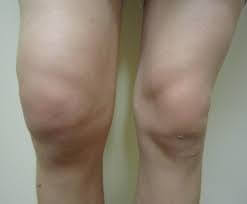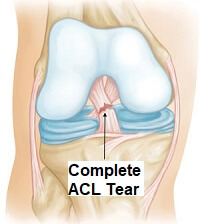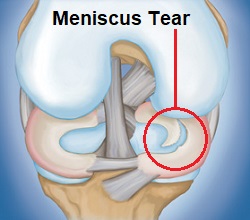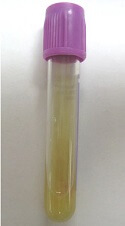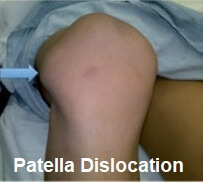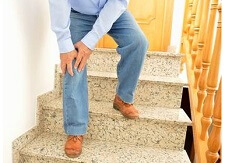- Home
- Knee Pain Diagnosis
- Swollen Knee
Swollen Knee
Written By: Chloe Wilson, BSc(Hons) Physiotherapy
Reviewed by: KPE Medical Review Board
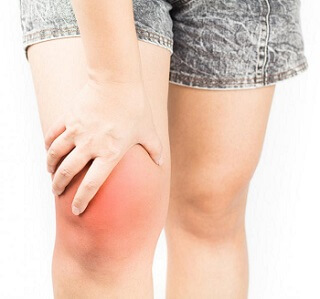
A swollen knee is a common problem caused by accumulation of fluid in, or around, the knee joint. Knee swelling is commonly referred to as "water on the knee" or a "knee joint effusion".
Swollen knees can develop suddenly or gradually, may be mild or severe and may limit the amount you can move your leg, making walking very uncomfortable. It may even be a sign of a serious medical problem.
Knee swelling most commonly develops after an knee injury but does sometimes come on for no obvious reason usually due to an underlying knee condition such as gout.
Small amounts of knee swelling may not be visible but can still cause problems. In other cases, the swelling may be more obvious and widespread.
Here we will look at common knee swelling causes, the different types of swelling and how to tell whether it's serious. Then we'll go on to look at the best swollen knee treatment options.
Why Does The Knee Swell?
A swollen knee is a common problem that affects people of all ages. Knee swelling typically indicates a problem somewhere inside the knee joint.
The knee has a joint capsule, which is like a sac that surrounds the whole joint. The capsule contains synovial fluid which nourishes and lubricates the joint so that it can move smoothly, think of it like the oil in your car. The joint capsule acts as container, keeping the fluid within the knee joint.
A swollen knee usually develops when excess fluid builds up inside the joint capsule and is caused by either:
- Bleeding in the Joint: aka
Haemarthrosis. This is normally caused by an injury and the knee
swelling comes on rapidly (within minutes). The swelling can be intense
making the knee feel very tight.
- Accumulation of Synovial Fluid: aka knee joint effusion or water on the knee. This type of swollen knee tends to come on gradually and may come and go, varying in degrees of severity.
Often, knee swelling remains inside the knee joint as the joint capsule acts like a barrier, preventing the fluid from escaping. However, it can also occur outside the joint capsule, known as extra-articular swelling, such as with knee bursitis.
When this happens, rather than there being general swelling around the knee there may be swelling behind the knee, side of knee swelling, front knee swelling, swelling below the knee or swelling above the knee.
Types Of Knee Swelling
Knee swelling usually develops in one of four ways:
- Rapid Swelling After An Injury: knee swelling comes on immediately after an injury e.g
- Delayed Swelling After An Injury: that appears a few hours after an injury
- Gradual Swelling Without An Injury: that develops and often fluctuates without an injury
- Rapid Swelling Without An Injury: that comes on very suddenly without an injury
Let's have a look at the features of each and then we'll look at the common causes.
1. Rapid Knee Swelling After An Injury
A swollen knee that develops immediately after an injury, within minutes, is usually due to haemarthrosis, where blood accumulates in the joint. Essentially what happens is that a structure inside the knee gets damaged and starts to bleed. The blood pools inside the capsule building up pressure in the joint.
Knee swelling after an injury is normally profuse and the knee typically balloons very quickly. It will feel tense and very sore and is often accompanied by bruising, although that may take longer to develop. A sudden, swollen knee caused by a haemarthrosis needs urgent medical attention.
2. Delayed Knee Swelling After An Injury
If a swollen knee develops anything from a few hours to a few days after an injury, it is most likely due to an increase in the synovial fluid in the joint – a knee effusion.
This happens when something inside the knee is damaged slightly causing irritation and a resultant increase in synovial fluid. The amount of swelling varies but it tends not to be as much as with a haemarthrosis and the swollen knee doesn’t usually feel tense.
3. Gradual Knee Swelling Without An Injury
A swollen knee that develops gradually is usual a sign of an underlying knee condition rather than an injury. The fluid on the knee tends to come and go and varies in amount. There is usually only mild to moderate amounts of swelling in these cases.
4. Rapid Knee Swelling Without An Injury
Occasionally, a swollen knee develops rapidly without any injury. In most cases it is due to an infection in the joint and requires urgent medical attention.
Common Causes Of A Swollen Knee
Let's have a look at the most common causes of a swollen knee and the features of each.
1. Ligament Tears
Ligament tears are a common cause of swollen knees. Ligaments are tough, fibrous bands which connect bone to bone and provide stability. There are two pairs of ligaments in the knee
- Collateral Ligaments: Medial & Lateral Collateral Ligaments (MCL & LCL) found on either side of the knee
- Cruciate Ligament: Anterior & Posterior Cruciate Ligaments (ACL & PCL), found in the middle of the knee joint
Ligament tears occur when one or more of the knee ligaments are stretched beyond their elastic limit and tear. The speed and amount of knee swelling with a ligament tear will depend on the extent of the damage.
- Knee Sprain: This is where some of the fibers are damaged, but the ligament remains intact. Mild to moderate knee swelling tends to develop slowly over 24-48 hours Learn More >
- Ruptured Ligament: This is where one or more of the knee ligaments ruptures i.e. tears completely. If there is a loud pop in the knee followed by pain and swelling, chances are you've ruptured one of the knee ligaments. Knee swelling comes on rapidly, tends to be extensive and it is often difficult to walk. ACL ruptures are the most common cause of rapid knee swelling with an injury. Learn More >
2. Meniscus Tears
Another common cause of knee swelling is a tear in the meniscus, the thick layer of cartilage that lines the knee.
Meniscus tears typically fall into two categories:
- Acute Tear: sudden injury e.g. twisting or landing awkwardly causes bleeding in the joint. Knee swelling will come on within 24-48 hours
- Chronic Tear: gradual wear and tear or irritation of the meniscus. Knee swelling tends to come on gradually and often fluctuates
The amount of swelling depends not only on how large the meniscus tear is, but also which part of the meniscus is damaged. The inner part of the meniscus has a poor blood supply so doesn’t tend to bleed much when damaged and therefore doesn't cause much swelling. However, the outer part does have and a tear in this region is a common cause of a swollen knee.
Common symptoms associated with a meniscus tear include locking (where the knee gets stuck) and pain on stairs and when squatting Learn More >
3. Bone Fractures
A break in one of the knee bones, such as a patellar fracture, will cause rapid, extensive knee swelling. It takes a good deal of force to break one of the knee bones and there may be an obvious deformity as well as a severely swollen knee. It will also be very difficult to walk or move the knee Learn More >
4. Knee Arthritis
Arthritis is the most common cause of gradual knee swelling in the over 60's, often referred to as water on the knee.
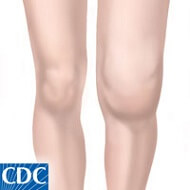
Osteoarthritis causes wear and tear in the knee joint. If an arthritic knee has been overworked, or gets knocked or twisted, the joint gets irritated and responds by producing extra synovial fluid to try and protect and heal itself. This results in a swollen knee.
Knee swelling from arthritis tends to come on gradually and often fluctuates. Learn More >
5. Infections
Knee infections are a potentially serious cause of a swollen knee. Infections can contaminate and increase in the amount of fluid produced in the joint. Knee infections usually develop after surgery or a deep cut, but sometimes an infection in your body can spread to your joint.
Knee swelling from an infection is often accompanied by a fever, intense knee pain and redness around the knee and requires immediate medical attention. The swelling often extends further down the leg towards the feet - find out more in the swelling below the knee section.
It is very difficult for your body to fight an infection within a joint. Treatment for an infected swollen knee may consist of antibiotics, aspiration (where the fluid is drained) and sometimes surgery.
6. Gout Knee
An intensely painful, swollen knee joint that develops rapidly, often at night, is often caused by gout. High levels of uric acid
(produced as part of the digestive process) cause sharp, needle like
crystals to form in your joints leading to inflammation and water on the
knee.
Gout is usually treated with medication and appropriate diet. Find out more about the causes, symptoms and treatment options in the Gout Knee section.
7. Knee Bursitis
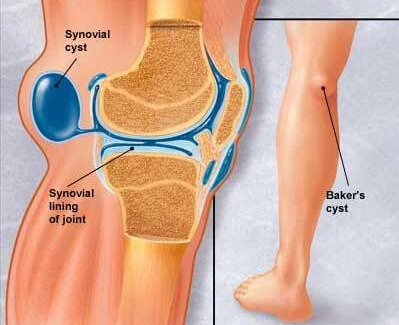
Pockets of swelling around the knee are often due to bursitis. Bursa are small fluid-filled sacs that sit between bones and soft tissues.
If there is excessive friction on them, they get inflamed and swell. You tend to get soft pockets of swelling rather than hard lumps or general swelling of the whole knee.
The location of the pocket of knee swelling depends on which bursa is affected:
- Kneecap Swelling: Swelling in front of the knee cap is usually caused by Pre-Patellar Bursitis, aka
Housemaids Knee
- Swelling Above The Knee: swelling just above the knee in the lower thigh is often due to Suprapatellar Bursitis
- Swelling Below The Knee: Swelling just below the kneecap may be from Infrapatellar Bursitis, aka Clergyman's Knee
- Posterior Knee Swelling: Swelling behind the knee, often like a squashy orange, is usually due to Popliteal Bursitis, aka
Bakers Cyst
- Medial Knee Swelling: Swelling on the inner side of the knee may be due to Pes Anserine Bursitis
Find out more about the causes, treatment and types of Knee Bursitis >
8. Haematoma
Blunt trauma to the soft tissues around the knee can cause bleeding. The blood collects around the muscles and can build up into a hard lump, known as a haematoma. If there is only a small amount of bleeding it is usually referred to as a contusion/bruise.
9. Bone Spurs
A common cause of a swollen knee in people over the age of 60 is knee bone spurs. These are outgrowths of excess bones that typically occur on the edges of the knee joint in response to excess pressure, friction and cartilage degeneration. The knee bone spurs may rub against the other knee structures resulting in irritation and friction which leads to knee swelling and pain.
You can find out more about the causes, symptoms, diagnosis and treatment options in the knee bone spurs article.
Rare Causes of a Swollen Knee
- Knee Cap Dislocation:The patella usually glides in a groove at the front of the knee but a forceful injury can push it out to the side, resulting in a mis-shapened, swollen knee. Learn More >
- Patellar Tendonitis: Irritation of the patellar tendon can lead to mild swelling at the front of the knee. Learn More >
- Tumour: There are various types of tumor that can cause knee swelling. They are often accompanied by fatigue, weight loss and a general feeling of being unwell.
- DVT: A deep vein thrombosis is a blood clot in one of the deep veins, most
common in the calf or thigh. They are normally painful, hot and red and are most
common after prolonged bed rest, surgery or air travel. A DVT is a medical emergency - if you suspect you may have one see your doctor immediately.
- Spontaneous Haemarthrosis: Sudden bleeding into the joint in someone with a blood clotting problem or who is taking blood thinners e.g. warfarin.
Swollen Knee Treatment
The most effective swollen knee treatment will depend on the cause of the knee swelling. Common tools for reducing knee swelling include:
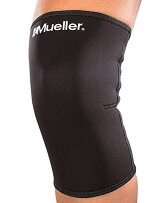
- Ice: to slow down the blood flow
- Medication: e.g. NSAID's such as ibuprofen can help reduce knee swelling
- Cortisone Injections: reduce inflammation and pain. May be combined with aspiration - draining of the fluid
- Exercises: Keeping the knee moving helps to push the fluid out of the knee joint
Other things that can help reduce knee swelling include compression bandages e.g. tubigrip, massage, and positioning and it is really important to get the right balance between rest and movement.
The amount of knee swelling may vary day to day and it may feel like it comes and goes as the injury is healing. It usually takes 6-12 weeks for soft tissues (i.e. muscles & ligaments) to heal, but cartilage injuries can take longer, as the cartilage has a very poor blood supply.
Find Out More: Best Swollen Knee Treatments >
What Else Can Help?
In most cases of a swollen knee, the whole joint swells up, but there are some knee conditions where the swelling forms a pocket at the back of the knee - find out more in the Swelling Behind The Knee section.
Alternatively, the swelling may be more on one side of the knee or above the knee - find out about the possible causes and how to treat them in the Side Knee Swelling, Swelling Above Knee, Swelling Below The Knee and Front Knee Swelling articles.
SAFETY ADVICE: Fluid on the knee can indicate a serious problem, and you should always see your doctor with any unexplained or persistent knee swelling.
If you have other symptoms besides a swollen knee such as instability, pain on the stairs or popping/cracking noises, then visit the knee symptoms guide for help working out what is wrong.
You might also be interested in the following articles:
- Knee Pain Diagnosis Chart
- Front Knee Pain
- Side Knee Pain
- Pain Behind The Knee
- Burning Knee Pain
- How To Improve Knee Range Of Motion
- How To Stairs With Knee Pain
Related Articles
Medical & Scientific References
1. Journal of the Royal Society of Medicine: The acute swollen knee: diagnosis and management. July 2013
2. Physiotherapy Journal: Efficacy of kinesiology taping in reducing knee swelling in patients who have undergone primary anterior cruciate ligament reconstruction. May 2015
3. Biomed Central: Short-stretch inelastic compression bandage in knee swelling following total knee arthroplasty study (STICKS): study protocol for a randomised controlled feasibility study. March 2015
Page Last Updated: 25/04/24
Next Review Due: 25/04/26
